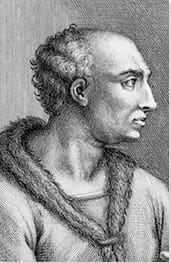Summary of Lorenzo Ghiberti
Ghiberti is credited (and was happy to credit himself) with creating one of the greatest masterpieces in fifteenth century Italian art, the east doors, known as the Gates of Paradise, for the Baptistery in Florence Cathedral. The Baptistery doors are considered the finest of all sculptural examples of the Late Gothic style in Italy. He produced many other influential works, such as three bronze statutes for Orsanmichele church, that saw him compared (favorably) with Donatello and Nanni di Banco, and the reliefs for the Siena Cathedral. In his late career, Ghiberti put his humanist ideals on perspective and classical form into writing too when he authored two influential volumes on art history, and art practice and theory, making him the first modern historian (predating Vasari by some 100 years) of fine arts. A third tome, an autobiography, is thought to be the first of its kind for any artist and secured them a status reserved previously only for rulers and saints.
Accomplishments
- The Gates of Paradise serve as some of the finest examples of Early Renaissance sculpture. They demonstrate Ghiberti's mastery of linear perspective and of the Classical idiom and his preference for the rectangular format helped him to achieve depth of space in the scenes. His figures, who, according to Vasari, "appear to move", are presented in high relief with figures further back in space presented in low relief. His technique of rilievo schiacciato (flattened relief) added to the sense of dynamic and complex space.
- Ghiberti produced the first large bronze statue - John the Baptist, the patron saint of Florence. The work, cast from a single piece, was considered a remarkable technical achievement for its time. It is an exemplar of the International Gothic style with its unnaturalistic, yet sophisticated, elegant curves in the figure's drapery and hair. The statute possessed a dignified quality that was carried in the exquisitely rendered details.
- Ghiberti's sculptures are amongst the most important of all Renaissance art. His success was spurred in part by a rivalry with the architect and sculptor Filippo Brunelleschi. Though both were engaged with modernist modes of humanist thought and naturalistic representation, Ghiberti's work did more to unite Classical and Renaissance ideals. Through his use of receding planes, he created a shallow relief that brought his idealized figures a sense of graceful movement when set against architectural backdrops.
- With I Commentarii (The Commentaries), Ghiberti complimented his practical work with a three-volume tome that effectively confirmed his place within the Florentine Renaissance. His views on art history and theory, that championed a blending of humanist and classical values of beauty; and his autobiography not only endorsed his own eminence, it helped elevate the status of special painters and sculptors to that of "genius".
The Life of Lorenzo Ghiberti
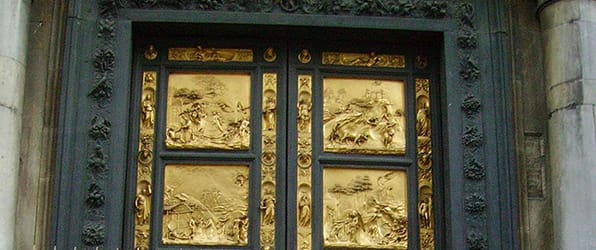
For Ghiberti, the finest art should carry a tactile dimension; for him the Classical female statue possessed "so much refinement the eyes could not appreciate by either strong or moderate light, only by the hand touching it could this be discovered".
Important Art by Lorenzo Ghiberti
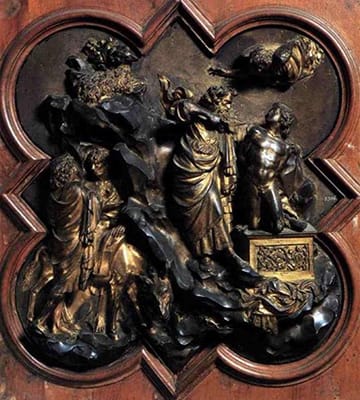
The Sacrifice of Isaac
Competitors for the 1401 commission of the new doors for the Florence baptistery were required to create a panel depicting the Old Testament story of Abraham´s sacrifice of his son, Isaac. In the story, God tells Abraham that he must sacrifice Isaac but at the moment he is poised to strike his son down with a knife, an angel appears to stop the fatal blow. Competitors were required to portray the scene and include the following elements within a quatrefoil form: Abraham, the donkey, the two male companions, the altar with wood and fire, Isaac, the intervening angel, and the ram. The two frontrunners in the competition were Ghiberti and Brunelleschi, each of whom treated the scene in slightly different ways. Moreover, as archaeologist Kayla Kandzorra notes "Ghiberti worked on his piece in a studio that was open to viewers, so he received public criticism and incorporated the feedback into his work [whereas] Brunelleschi worked in secrecy so the public would be surprised when his art was revealed".
While Brunelleschi divided his composition horizontally over the back of the donkey, Ghiberti divided his scene in half both vertically and diagonally (using the slanted edge of the mountain in the background). To the left, he placed the donkey and the two companions who look at each other, and bear witness to the main scene. At the top of the mountain, Ghiberti places the ram, and at the same level, on the right-hand side, the floating angel points to the ram as if suggesting it as an alternate sacrifice. Whereas Brunelleschi depicted the precise dramatic moment when the angel grabs Abraham's arm, Ghiberti opted to depict the moment just prior to this, when Abraham has the knife pointed at Isaac's throat. Whereas Brunelleschi focused on the tensest moments of the scene, Ghiberti showed restraint and delicacy, with Abraham's arm held back, allowing the viewer to believe that perhaps he is not capable of murdering his own son. At the same time, however, Ghiberti imbues his panel with a sense of movement, as the foreshortened angel flying overhead, and the twisting head of Isaac, create a dynamic sense of action.
Ghiberti's version of the scene presents Isaac's beautifully rendered nude torso, exemplifying his skill at depicting human anatomy. He also demonstrates his talent for sculpting drapery, as seen, for instance, in Abraham´s clothing, Isaac's robe, and Abraham's beautifully coiffed and curled hair. Considering that the commission came from the Arte di Calimala (Cloth Importers Guild), this attention to the representation of cloth and wool would likely have helped Ghiberti secure the win. But a further practical factor went in Ghiberti's favor. Ghiberti's technique meant that his panel weighed significantly less than Brunelleschi's, which would have translated into significant cost savings. The shrewd Ghiberti also understood that this work would serve as a sort of advertisement for his services, seen on one of the city's most important buildings (the Baptistery). It was thus of the utmost importance that he demonstrated his skill in depicting beauty as a way of appealing to Florence's merchant class. At the same time, Ghiberti's panel appealed to the new Renaissance sensibility in that it featured more natural elements, as well as references to Classical poses, facial expressions, and architectural elements (as seen on the frieze of the altar).
Bronze - Museo dell'Opera del Duomo, Florence
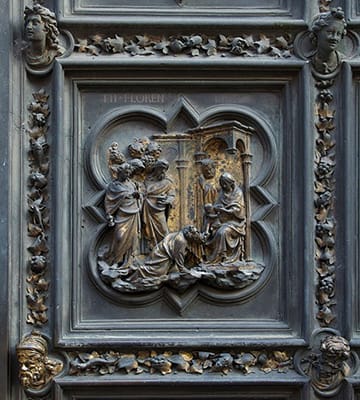
Adoration of the Magi (North Doors)
Ghiberti won a competition in 1401 to design the east doors (only later moved to the north doorway) of the Florence Baptistery (beating Filippo Brunelleschi, the architect responsible for the famous dome at the Basilica di Santa Maria del Fiore). Although the original plan for the doors was to feature scenes from the Old Testament, a decision was taken to focus on the New Testament instead. Ghiberti designed 28 panels - two columns of seven on each door - featuring biblical vignettes. The panels are surrounded by sculpted foliage and gilded busts of prophets and sibyls. Writing many years later in his I Commentarii (The Commentaries) collection, Ghiberti explained that the contract to produce the doors stipulated that he alone would work on the figures and trees (the features that won him the original competition) and his hand-picked assistants would be allowed to work only on other areas of the panels.
Intended to replace existing doors by Andrea Pisano (by now a hundred years old and subsequently moved to the south doorway), Ghiberti reversed the reading direction from Pisano's top-to-bottom design (to a bottom-to-top reading). Ghiberti's design also differed from Pisano's in that he drew influence from the then-popular Parisian international court style (known today, after the writings of the nineteenth-century French art historian, Louis Courajod, as International Gothic). This style is evident in The Adoration of the Magi in the elegant and decorative way in which the folds of the figures' drapery are portrayed, as well as in the vertical placement of the figures in the group, who gradually appear slightly above one another in the receding picture plane. In the composition, the kneeling king and the complex architectural elements draw further attention to the main figures in the scene (namely the King, the Christ child, Mary, and Joseph).
These, and his next (more famous) set of doors for the Baptistery, were produced in gilted bronze. Bronze was very expensive at that time (ten times the price of stone for instance) but Ghiberti was backed by his generous donors (Arte di Calimala (the Wool Merchants Guild)) - who covered the cost of all materials and even a purpose built furnace for his workshop - who trusted him to create the doors he had promised. Ghiberti delivered on his promise, albeit some 11 years over the original 10-year schedule; the magnificent doors finally installed on April 19, 1424. Ghiberti's reputation was secured, and future commissions saw him become a wealthy, and very highly regarded, society figure.
Bronze - Museo dell'Opera del Duomo, Florence
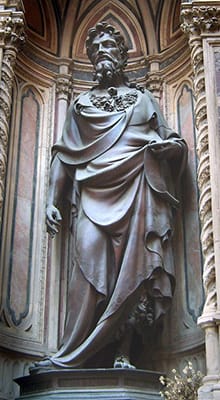
St. John the Baptist
This statue of John the Baptist, the patron saint of Florence, was the first large bronze work in Florence, and represents an impressive technical achievement for its time, in that it was cast in a single piece. Indeed, Ghiberti had to accept financial liability if his ambitious undertaking did not come to fruition. The work follows the International Gothic style, as seen in the unnaturalistic, yet elegant, flowing curves of the figure's drapery and hair, and the general dignity of the work. Ghiberti exquisitely renders finer details too, including the goatskin cloak, the beard and hair, and the Saint's expression, which shows a slightly furrowed brow. His eyes are inlaid with silver.
This statue was commissioned by the Arte di Calimala guild (the Wool Merchants Guild) and was funded by the wealthy Arte del Cambio guild (the Bankers Guild). It was installed in a niche on the exterior of the Orsanmichele church in Florence. It was so highly praised, in fact, that Ghiberti was subsequently commissioned to create two more bronze works of similar proportions: St. Matthew (1419) for the Bankers Guild, and St. Stephen (1425) for the Wool Merchants Guild. As historian Mark Cartwright explains, the first statue of Saint John the Baptist is generally considered the "finest" of the three works, although the statue of Saint Matthew "is captivating for his poise and gesture similar, one might imagine, to an orator in the Roman Senate".
Commenting on his Orsanmichele sculptures, Cartwright observed that Ghiberti "was a keen student of the surviving art from antiquity and especially classical artist's preoccupation with human anatomy and proportion [and that he] even had his own small collection of antique pieces". He adds that specific influences (in addition to the fashionable International Gothic style) "came from such renowned sculptors as his fellow-Florentine Donatello, who had actually been an assistant to Ghiberti early in his career [and from] those metalworkers he had contacts with from northern European, particularly German craftsmen".
Bronze - Orsanmichele, Florence
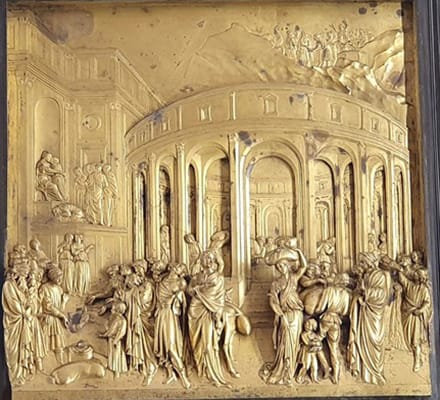
The Story of Joseph (The Gates of Paradise)
Ghiberti's first set of doors (the north doors as they are referred to now) for the Florence Baptistery are rightly admired for the quality of their design and execution and stand as exemplars of the International Gothic style. However, his second set, christened by Michelangelo, the "Gates of Paradise", emphatically confirmed his genius and secured him his place in the pantheon. The two doors each feature five gilded bronze panels showing amalgamated scenes from the Old Testament. Around the panels there is a frame that contains representations of famous Biblical figures and contemporary artists (and even the heads of Ghiberti and his son, Vittorio). In the Joseph panel, Ghiberti combines the narratives of Joseph cast by his brethren into the well; Joseph sold to the merchants; the merchants delivering Joseph to the Pharoah; Joseph interpreting the Pharaoh's dream; the Pharaoh paying him honour; Jacob sending his sons to Egypt; and Joseph recognizing his brothers and returning home.
In comparison with his panels for the earlier north doors, these panels are more naturalistic in terms of Ghiberti's use of perspective and the rendering of the figures. Art historian Giorgio Vasari noted that of all the ten panels on the Gates of Paradise, the Joseph panel was the most difficult, and also most beautiful. Vasari wrote: "[Ghiberti] showed such invention, order, manner, and design, that his figures appear to move and to have souls". While the foreground figures are presented in high relief (leading to nearly free-standing figures), the figures further back are presented in low relief, following Donatello's technique of rilievo schiacciato (flattened relief), and the rest of the panel involves the application of incised lines, creating a very dynamic and complex sense of space.
The use of the rectangular (rather than quatrefoil) format, moreover, allowed Ghiberti to explore depth of space fully in all the scenes. As Cartwright writes: "The [ten] panels contain figures rendered in such high relief they are almost completely in the round. Each panel has clever devices of perspective, which give the illusion of real depth in scenes which are quite complex with multiple areas of action". He adds that "the panel showing the story of Joseph (son of Jacob) is a particularly fine example of Ghiberti's skill at rendering depth with the double layer of receding architectural features behind the crowd of foreground figures".
Bronze - Museo dell'Opera del Duomo, Florence
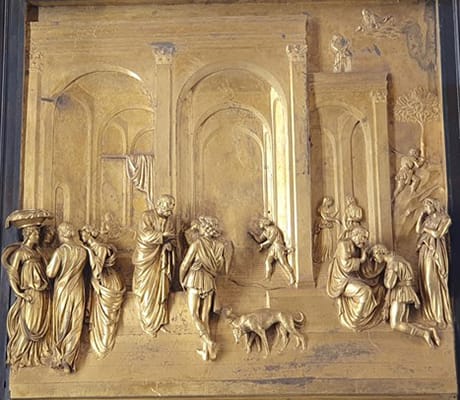
Jacob and Esau (The Gates of Paradise)
In this panel from the Gates of Paradise, Ghiberti blends episodes from the story of Jacob and Esau, including: Rebecca's conversation with God before the twins are born; Rebecca on the birthing bed; Esau's selling of his birthright to Jacob for a pot of porridge; Isaac telling Esau he will be blessed if he goes out to hunt; Esau leaving for the hunt; Rebecca's instructing of Jacob of her intended deceit; and Jacob's receipt of the blessing originally meant to be bestowed upon Esau. Some of the figures wear more contemporary style clothing (such as the tunics on the young boys) while other figures (such as the women) wear classically styled biblical robes.
As in the other panels of the Gates of Paradise, Ghiberti combines high- and low- relief elements in the same work, creating a complex sense of spatial depth. Following Brunelleschi's (re)discovery of liner perspective, Ghiberti creates a realistic sense of space which recedes toward a central vanishing point in the background. Moreover, Ghiberti continues to look to Classical art, including such architectural elements as pilasters and corinthian columns, as well as graceful Classical contrapposto poses. His approach to the rendering of human forms and narrative style influenced his contemporaries, for instance in Bartolommeo di Giovanni's Scenes from the Life of Saint John the Baptist (1490-95) wherein the artist creates an open view of an interior space, and places figures in discrete groupings (demarcating scenes of a story) across the composition.
Cartwright writes "When Michelangelo saw Ghiberti's doors he described them as worthy for the gates of Paradise, and this name has been used to describe them ever since. There is an additional connection with paradise as 'paradiso' was the name Florentines used to refer to the space between the Baptistery and the cathedral because the latter was used as the last resting place of important figures. Ghiberti's doors would secure his position amongst the finest of Renaissance artists [ ...] The Florentine authorities were so impressed with the results of their commission that they had Ghiberti's first set of doors moved to the north side so that the new ones could take the best position facing the cathedral. To ensure the sculptor's greatest work survives for future generations the panels were cleaned and moved to the Museo dell'Opera del Duomo in Florence. Replicas are now in their place on the Baptistery doors".
Bronze - Museo dell'Opera del Duomo, Florence
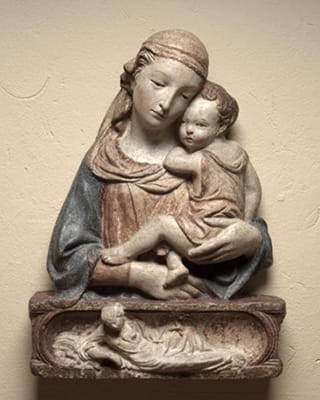
Madonna and Child
This widely copied sculpture presenting the Madonna and child, was intended for private devotion and was typically placed in bedrooms within a colmo da camera, that is, an architectural frame usually situated within a wooden tabernacle or painted niche. In this work, the Madonna is holding the Christ child in her arms, close to her bosom, with the child's cheek nestled against her neck, and his forehead against her cheek. In this way, the work powerfully emphasizes the humanity and vulnerability of these holy figures. While the sheer volume of similar works makes it difficult to pin down which artist was the first to create this specific form, art historians Wilhelm Bode, John Pope-Hennessey, Giancarlo Gentilini, and Richard Krautheimer agree that this early example was very likely created by Ghiberti (and was possibly his last significant work). This view is bolstered by the fact that Ghiberti would have been adept in the use of clay as it was an important material in the bronze production process.
Moreover, the twisting pose, and the folds in the drapery, of the Christ child strongly resemble those seen in the representation of a mother and child in Ghiberti's Moses panel of the Gates of Paradise. The devotional sculpture invites a tactile engagement on the part of the viewer, in that the Christ child presents his right foot in an invitation to be touched. Ghiberti wrote specifically about the important tactile dimension of Classical religious sculpture, at one time recording his encounter with a Classical sculpture of a hermaphrodite, noting that "In this statue was the greatest refinement, which the eye would not have discovered, had not the hand sought it out". Elsewhere, he commented on his experience with a newly discovered Classical female statue, that the figure had "so much refinement [that] the eyes could not appreciate by either strong or moderate light, only by the hand touching it could this be discovered".
Gilded terracotta with polychrome decoration - Cleveland Museum of Art, Ohio
Biography of Lorenzo Ghiberti
Childhood
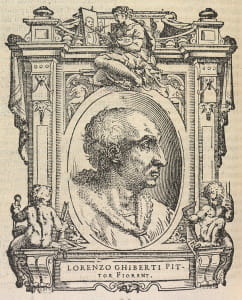
Ghiberti was born in Pelago, on the outskirts of Florence to Fiore Ghiberti. Although he frequently claimed his father was Fiore's first husband, Cione di Ser Buonaccorso Ghiberti, this has never been confirmed. It is known that when he was still a young boy, Fiore moved to Florence where she lived with her common-law husband, goldsmith Bartolo di Michele (who also went under the name Bartoluccio) who served as the principal father figure in Ghiberti's life. The two had a close and loving relationship, and Bartolo trained young Lorenzo in his trade, introducing him for the first time to the principles of three-dimensional design. Ghiberti was also educated in literacy and mathematics and read Latin and ancient texts.
Ghiberti signed his name variously as Lorenzo di Bartolo, Lorenzo di Bartolo Michele, and Lorenzo di Bartoluccio, indicating that he considered himself very much Bartolo's son. At other times, however, he claimed to be Cione's son; signing his name, Lorenzo di Cione di ser Buonaccorso. (This seems to be a practical decision that allowed him to claim an inheritance following Cione's death in 1406. It wasn't until 1413, after years of negotiating, that he reached a compromise with relatives and received a reduced inheritance. Ultimately, the confusion surrounding his origins had negative effects on his career when, in 1444, he was denounced as ineligible to hold public office because of his illegitimate birth.)
Education and Early Training
As a youth in Florence, Ghiberti received formal training in painting from Gherardo Starnina before devoting himself full-time to the workshop of Bartoluccio. It was here that he befriended the artist Antonio di Pollaiolo. In 1400, around the time that the bubonic plague struck, Ghiberti left Florence "because of the corruption of the air and the bad state of the city". He relocated to Rimini where he gained employment completing wall frescoes in the palace of Carlo Malatesta for the Lord of Pesaro.
In 1401, Ghiberti received word from his friends in Florence that the governors of the Baptistery and the Arte di Calimala (Cloth Importers' Guild) were holding a competition for artists skilled in bronze working, to win the commission of designing a new set of doors for the Baptistery of the Florence Cathedral. He returned to Florence, winning the competition and narrowly pushing out his great rival Filippo Brunelleschi in the process. The Baptistery had three doorways with Ghiberti's completed doors placed - some 21 years after commencement of the project - in the east doorway. (The south doors, themselves originally positioned on the north doorway, were produced by Andrea Pisano. Ghiberti's first series was initially placed on the east doorway, but later moved to the north with his second series - known after Michelangelo's glowing endorsement, as The Gates of Paradise (1425-52) - replacing them in the more prominently placed east doorway.)
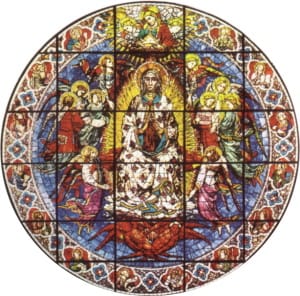
To complete the commission (of which he took sole legal control in 1407), Ghiberti set up in Bartolo di Michele's workshop where several important artists were trained, including Donatello, Uccello, Masolino, Michelozzo, and Antonio Pollaiuolo. Such was the significance of the commission the workshop immediately became the most import of all Florentine workshops and Ghiberti's personal fame was already secured. Completion of the north doors would take a little over twenty years, but during that time Ghiberti worked on other projects for the Cathedral in the capacity as architectural consultant, creating several spectacular stained-glass window designs.
Mature Period
Ghiberti had matriculated into the Goldsmiths' Guild in 1409 (having overcome legal complications with the legitimacy of his birth). The Arte dei Mercanti di Calimala (the Guild of Merchant Bankers) commissioned him in 1412 to produce a large bronze statue of their patron saint, St. John the Baptist, which would take pride of place outside its communal building, the church of Orsanmichele. As art historian Constance Lowenthal states, "The job was a bold undertaking, Ghiberti's first departure from goldsmith-scale work; it was, in fact, the first large bronze in Florence" and the work was completed in 1416 (Ghiberti adding gilding the following year). As art historian Mark Cartwright describes it, "Ghiberti did his own casting (not all famous artists did) using the direct lost-wax technique, that is creating a wax model with a clay core which was then covered in clay and baked in order to melt out the wax so that the space left could then be filled with melted bronze. However, the part of the process Ghiberti really showed his mastery of metal was in his ability to 'chase' or finish a cast piece, that is to use files, chisels and pumice stone to remove imperfections and bring the metal to shining life".
Around 1416, and by now in his late thirties, Ghiberti married Marsila, the sixteen-year-old daughter of comb-maker Bartolommeo di Lucca. They had two sons, Tommaso in 1417, and Vittorio in 1418. (Vittorio later took up his father's trades, working in goldsmithing and bronze casting, and Tommaso went on to join his father's business, helping as a collaborator with the assistants.)
Ghiberti was in such demand that a 1417 commission from the Siena Cathedral for two bronze reliefs for its baptismal font took him ten years to complete (and only then under pressure to complete from the Sienese authorities). In 1419, Pope Martin V visited Florence and, in his capacity as a goldsmith, Ghiberti made a morse and mitre of precious metal and stones for the pontiff. The success of the St. John the Baptist statute was such that Ghiberti won commissions for two further statues, Saint Matthew (1419) and Saint Stephen (1425), for the bankers' guild and the wool guild respectively (and both also situated in the grounds of the Orsanmichele).
Lowenthal explains how the St. John statute brought Ghiberti "into open competition with the newly prominent younger sculptors Donatello and Nanni di Banco" both of whom followed Ghiberti with stone statues (St. Mark and St. George, and St. Philip and Four Crowned Saints, respectively) that were also situated in the grounds of the Orsanmichele Church. He adds that Ghiberti's St. John "still followed many of the conventions of the Gothic tradition" in the way that it "combined small-scale details with a larger-than-life scale that made the figure appear overwhelmed by the drapery", whereas Donatello's and Nanni di Banco's figures "were designed with monumental proportions to match their scale". Lowenthal observed that the "boldness and strength of the weighty new classical figures constituted a challenge for Ghiberti" but that "he met it with success in his next sculptures [Saint Matthew and Saint Stephen] and maintained his preeminent position as a leading artist in Florence".
In 1418 Ghiberti found himself once more in direct competition with Brunelleschi for the commission to execute the dome at the cathedral of Santa Maria del Fiore. In truth, neither man was well qualified to undertake architectural work, yet both still submitted drawings and models. On this occasion Brunelleschi won the competition but it came with the caveat that Ghiberti worked on the project with his old rival. Legend tells it that Brunelleschi took to his sick bed to leave Ghiberti in charge and thereby expose his incompetence as an architect. (Ghiberti, who abandoned the project in 1425, would later claim part credit for the finished dome (completed in 1436) but, as Lowenthal contest, "it is unlikely that he actually collaborated with Brunelleschi" and so credit for the dome rightly goes to Brunelleschi.)
Around 1420 Ghiberti met Cosimo de Medici, and the prominent Medici family commissioned Ghiberti to create a shrine for the convent of Santa Maria degli Angeli, to hold the relics of Saints Protus, Hyacinth, and Nemesius. However, Ghiberti never became particularly close to the Medici, nor did he undertake any major projects for them or, for that matter, any other prominent Florentine families.
In 1425 Ghiberti was commissioned to design a second pair of bronze doors for the Florence Baptistery. This time, the undertaking would take a little under 20 years. It was time well spent with the finished doors standing as an unequivocal Renaissance masterpiece that Michelangelo called "truly worthy to be the Gates of Paradise". Originally the Gates of Paradise (the name by which they are now universally known) were to have 28 figural panels (as in the earlier sets of Baptistery doors) but he scaled down the project to just ten panels.
The Art Institute of Chicago states: "the Gates of Paradise have been praised by generations of artists and art historians for their compelling portrayal of scenes from the Old Testament. Over time, the seventeen-foot-tall, three-ton bronze doors became an icon of Renaissance art and a touchstone of civic and religious life in Florence [ ...] The narrative panels [ ...] are framed by a series of 20 prophets in niches alternating with 24 projecting heads. The standing figures [ ...] represent Old Testament prophets, heroines, and sibyls, generally credited with foretelling the birth of Christ. The heads also depict prophets [but also] include portraits of Ghiberti and his son Vittorio [ ...] The elements of the doorframe amplify the main themes of the narrative panels and serve as another example of Ghiberti's artistic inventiveness".
By 1427 Ghiberti was a wealthy man and prominent society figure. He owned a house and a thriving workshop in Florence, a modest vineyard on the city's outskirts, owned several government bonds and investments, and made visits to Venice and Rome. In 1427 he created the bronze tomb slab of the Dominican general, Leonardo Dati, at the Church of Santa Maria Novella, Florence. Indeed (with Donatello and Michelozzo) Ghiberti is credited with elevating the hitherto "artless" status of the tomb slab to that of raised monument.
He also presented (a decade after the initial commission, and some eight years after the first agreed completion date) a bronze plate for the new baptismal font for the Siena Cathedral, Duomo di Santa Maria Assunta. The marble font and basin were to be adorned with a total of six relief plaques that were produced by a coterie of sculptors (including Donatello, Giovanni di Turino and Jacopo della Quercia). Ghiberti's plaque showed the Baptism of Christ and is described by the cathedral as "an elegant and sophisticated scene with a painterly quality and a sense of perspective achieved thanks to [Ghiberti's] adoption of the "stiacciato" (very flat, low) relief technique".
By the end of the decade, and following the completion of the first doors, Ghiberti began to explore new ways of representing full, animate, human figures placed in a receding, but shallow, pictorial space. Indeed, in his comparison with Donatello, art historian E. H. Gombrich wrote: "Of Donatello's work we could say everything was new, Ghiberti's looks much less startling at first sight [ ...] he does not give us the idea of real space at which Donatello was aiming. He prefers to give us only a hint of depth and to let his principal figures stand our clearly against a neutral background".
Late Period and Death
Ghiberti formed a close friendship with humanist scholar Leon Battista Alberti with whom he shared the view that beauty in art was synonymous with antiquity and equal to nature. As Lowenthal argues, for Ghiberti and Alberti, "capturing [nature's] essence meant revealing life by depicting movement, life's most salient visible characteristic¨. Ghiberti also formed a close friendship with the Fra Angelico and designed the marble aedicula (small shrine) for Fra Angelico's Linaiuoli Altarpiece (1432-33). At this time, he commenced work on the Shrine of St. Zenobius, a bronze casket featuring relief panels showing the deeds of the saint's life, for Florence Cathedral which was not completed until 1443.
Around 1447, Ghiberti completed his written work I Commentarii (The Commentaries) a three volume collection contained his views on art practice and art history. Cartwright states that in The Commentaries "Ghiberti deplores the destruction of the art of ancient Rome and Greece by the Christian Church but takes heart from the revival in interest in antiquity and the rejuvenation of art in general, which was begun by such painters as Giotto". It also stands as the earliest surviving autobiography - in which Ghiberti situated his own achievements within the broader narrative of Western art history - by any artist. Lowenthal writes that "The Commentaries demonstrate Ghiberti's confidence in his position as an important leader in the Florentine Renaissance - one interested in recapturing the art of the ancients and studying it as a humanist scholar would, and one who developed a new style all'antica [in the manner of the ancients] in which he freely created artworks with a grace and beauty that have been found winning since their invention".
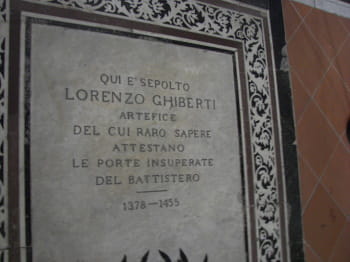
Ghiberti stated that "few important things were done in our city [Florence] which were not devised or designed by my hand". It was a boast that carried not a little authority. As Arthur Lubow, writing about The Gates of Paradise for The Smithsonian, states, Michelangelo's "phrase stuck, for reasons that anyone who has seen them will understand. Combining a goldsmith's delicacy with a foundryman's bravura [Ghiberti] condensed the Old Testament into ten panels to produce one of the defining masterpieces of the Italian Renaissance". Ghiberti died at the age of seventy-five after succumbing to a fever. He was buried on December 1, 1455, in a tomb he had purchased several decades earlier at Santa Croce in Florence. Cartwright asked ruefully: "one wonders if he ever made it to Paradise and what he thought of the entrance gates".
The Legacy of Lorenzo Ghiberti
The sculptural works Ghiberti created during the fifteenth century stand today as some of the most important and monumental landmarks in Florence and in Renaissance art per se. His rivalry with Filippo Brunelleschi pushed both to great heights; encouraging Ghiberti to develop Renaissance Humanism and naturalistic representation while never losing sight of the beauty of Classical art forms (particularly in the representation of human figures and architectural forms). As art historian Richard Krautheimer summed up, Ghiberti's "work was seen as the bridge between the Middle Ages and the Renaissance".
Ghiberti's advancements in the use of perspective influenced subsequent generations of artists, including Paolo Uccello and Donatello, both of whom worked directly under Ghiberti in his workshop. London's V&A Museum says of Ghiberti, he "was a most celebrated bronze-caster, sculptor, goldsmith, draughtsman, architect and writer and the first representative of the universal Renaissance artist. His art reached its most brilliant expression in the Gates of Paradise [and no] other contemporary artist had so deep an influence on the art and sculpture of later times". Commenting on his writing, I Commentarii (The Commentaries), meanwhile, Historian Mark Cartwright suggests that it represented "a sign of the times: artists were no longer considered mere craftworkers as there was an obvious intellectual element to their work as they studied the past and considered such theories as mathematical perspective. Further, art was becoming an essential and important element in how a city or state viewed itself".
Influences and Connections

-
![Giotto]() Giotto
Giotto -
![Leon Battista Alberti]() Leon Battista Alberti
Leon Battista Alberti - Bartolo di Michele
- Gherardo Starnina
-
![Donatello]() Donatello
Donatello -
![Fra Angelico]() Fra Angelico
Fra Angelico - Antonio del Pollaiolo
- Masolino
- Michelozzo
-
![Renaissance]() Renaissance
Renaissance -
![Classical Art]() Classical Art
Classical Art - International Gothic
-
![Donatello]() Donatello
Donatello -
![Fra Angelico]() Fra Angelico
Fra Angelico - Antonio del Pollaiolo
- Masolino
- Michelozzo
Useful Resources on Lorenzo Ghiberti
- The Feud That Sparked the Renaissance: How Brunelleschi and Ghiberti Changed the Art WorldBy Paul Robert Walker
- Lorenzo Ghiberti: Volume IOur PickBy Richard Krautheimer
- Lorenzo Ghiberti: Volume IIOur PickBy Richard Krautheimer
- The Story of ArtBy E. H. Gombrich
 Ask The Art Story AI
Ask The Art Story AI